 |
Reno Air Races: Aircraft Classification and Rules
| Unlimited Class: | |
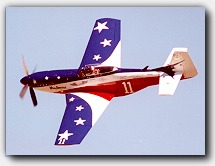 Even though this racing class is
called "unlimited" there are certain
restrictions placed upon all entries. All aircraft must
have piston engines, be propeller driven, and capable of
pulling 6 G’s. Besides that, this class is basically
a "no-holds-barred" affair operating within
these few requirements. Anything goes! Even though this racing class is
called "unlimited" there are certain
restrictions placed upon all entries. All aircraft must
have piston engines, be propeller driven, and capable of
pulling 6 G’s. Besides that, this class is basically
a "no-holds-barred" affair operating within
these few requirements. Anything goes! From exotic fuel blends and nitrous injection, to powerful Griffon/Merlin V-12’s and bodacious monster P&W R-4360’s, to custom composite airframes and highly modified WWII fighters. These are without a doubt Reno’s "Big Guns" and air speeds often exceed 500 MPH on portions of the 9.128 mile race course. |
|
| AT-6 Class: | |
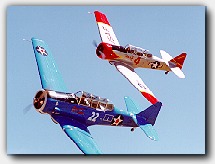 This class must abide by a specific set of
guidelines in order to compete. Aircraft that are
eligible to compete must be one of the three different
types (all are variations of the same model) of WWII
trainers - AT-6, Harvard’s, or SNJ’s. All
entries must use the 650 HP, nine cylinder Pratt &
Whitney R-1340 radial engine. While crews are not allowed
to increase the cubic-inch displacement of their P&W
powerplant, they are allowed to blueprint the engine (In
blueprinting the engines crews often balance the pistons,
polish the heads and cylinders, polish the blower and
polish the carburetor). The crews are also allowed to
fill open seams and wax/polish the aircraft to make them
more aerodynamically clean. Last but not least, the crews
are allowed to remove the rear seat to reduce overall
weight. All this leads to a highly competitive nearly
stock class of racers who compete on a 4.990 mile race
course in some of the tightest battles seen at the annual
event. This class must abide by a specific set of
guidelines in order to compete. Aircraft that are
eligible to compete must be one of the three different
types (all are variations of the same model) of WWII
trainers - AT-6, Harvard’s, or SNJ’s. All
entries must use the 650 HP, nine cylinder Pratt &
Whitney R-1340 radial engine. While crews are not allowed
to increase the cubic-inch displacement of their P&W
powerplant, they are allowed to blueprint the engine (In
blueprinting the engines crews often balance the pistons,
polish the heads and cylinders, polish the blower and
polish the carburetor). The crews are also allowed to
fill open seams and wax/polish the aircraft to make them
more aerodynamically clean. Last but not least, the crews
are allowed to remove the rear seat to reduce overall
weight. All this leads to a highly competitive nearly
stock class of racers who compete on a 4.990 mile race
course in some of the tightest battles seen at the annual
event. |
|
| T-28 Class: | |
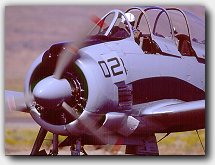 It is unknown at this time, the
specific rules that will regulate this class of racers,
though it is assumed that these rules will be very
similar to that of the T-6’s. Unlike the T-6 racers,
T-28’s were manufactured with different engines and
displacements, so there will be *some* differences. As
soon as all the particulars are known we will present
them here. While mechanically friendly by design, the
T-28 doesn't lend itself naturally to aerodynamic or
engine modifications, thus we can expect to see a large
number of "stock" aircraft. With cowl flaps and
oil cooler doors closed, these aircraft can reach speeds
of 300 MPH, however system temperatures preclude such
speeds for the duration of the race. We can expect to see
considerable lead changes and passing among this class as
pilots manage engine and oil temperatures lending this
class to be highly competitive. It is unknown at this time, the
specific rules that will regulate this class of racers,
though it is assumed that these rules will be very
similar to that of the T-6’s. Unlike the T-6 racers,
T-28’s were manufactured with different engines and
displacements, so there will be *some* differences. As
soon as all the particulars are known we will present
them here. While mechanically friendly by design, the
T-28 doesn't lend itself naturally to aerodynamic or
engine modifications, thus we can expect to see a large
number of "stock" aircraft. With cowl flaps and
oil cooler doors closed, these aircraft can reach speeds
of 300 MPH, however system temperatures preclude such
speeds for the duration of the race. We can expect to see
considerable lead changes and passing among this class as
pilots manage engine and oil temperatures lending this
class to be highly competitive. |
| Formula 1 Class: |
 This class must conform to a
specific set of guidelines in order to compete. All
aircraft must adhere to the following requirements: a
minimum dry empty weight of 500 pounds, non-retractable
landing gear, a minimum wing area of 66 square feet, a
fixed-pitch propeller constructed of either wood or
composite materials and a 100 HP 200 cubic-inch
Continental engine. Formula 1 Class air racing was
introduced at the Cleveland Air Races in 1947 with the
intent to enable pilots to design, build and race their
own planes at an affordable price. Because of these
features it is a very popular class of air racing for
pilots to compete in, with many very competitive entries.
The Formula I class has several races across the country
throughout the year with Reno serving as the site for
their National Championship and their biggest purse. At
Reno, the race course distance covers 3.1068 miles. This class must conform to a
specific set of guidelines in order to compete. All
aircraft must adhere to the following requirements: a
minimum dry empty weight of 500 pounds, non-retractable
landing gear, a minimum wing area of 66 square feet, a
fixed-pitch propeller constructed of either wood or
composite materials and a 100 HP 200 cubic-inch
Continental engine. Formula 1 Class air racing was
introduced at the Cleveland Air Races in 1947 with the
intent to enable pilots to design, build and race their
own planes at an affordable price. Because of these
features it is a very popular class of air racing for
pilots to compete in, with many very competitive entries.
The Formula I class has several races across the country
throughout the year with Reno serving as the site for
their National Championship and their biggest purse. At
Reno, the race course distance covers 3.1068 miles. |
| Biplane Class: |
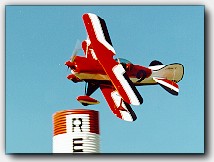 This class must also comply with
rules that regulate the size and power of their craft.
Biplanes must have a minimum dry weight of 500 pounds, at
least 30 percent of the required 75 square foot wing area
must be contained in the smaller of the two wings,
non-retractable landing gear, a fixed pitch propeller,
and the largest engine permitted is the 360 cubic-inch,
180 HP Lycoming engine. The racers utilize the same
3.1608 mile race course as the Formula 1’s and
similarly utilize a "race horse" start. The
biplanes are very agile and tend to do allot of upward
and downward maneuvering while they race at speeds
approaching 200MPH. A very exciting class, the biplanes
are considered by many to be the closest of all classes
with the differences between 1st and 3rd
place measured in mere fractions of seconds. This class must also comply with
rules that regulate the size and power of their craft.
Biplanes must have a minimum dry weight of 500 pounds, at
least 30 percent of the required 75 square foot wing area
must be contained in the smaller of the two wings,
non-retractable landing gear, a fixed pitch propeller,
and the largest engine permitted is the 360 cubic-inch,
180 HP Lycoming engine. The racers utilize the same
3.1608 mile race course as the Formula 1’s and
similarly utilize a "race horse" start. The
biplanes are very agile and tend to do allot of upward
and downward maneuvering while they race at speeds
approaching 200MPH. A very exciting class, the biplanes
are considered by many to be the closest of all classes
with the differences between 1st and 3rd
place measured in mere fractions of seconds. |
| Sport Class: |
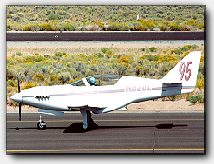 This class is open to production
kit-built aircraft powered by a reciprocating engine with
a displacement of 650 cubic inches or less. Aircraft must
have a current FAA Airworthiness Certificate. Pilots must
have at least 500 hours of flight time-in-type, and be
EAA formation flight certified to participate in a race.
The Sport Class Air Racing Association has developed a
racing format for this new class of aircraft which will
be made available as soon as it is known. This class is open to production
kit-built aircraft powered by a reciprocating engine with
a displacement of 650 cubic inches or less. Aircraft must
have a current FAA Airworthiness Certificate. Pilots must
have at least 500 hours of flight time-in-type, and be
EAA formation flight certified to participate in a race.
The Sport Class Air Racing Association has developed a
racing format for this new class of aircraft which will
be made available as soon as it is known. |
| General Rules of Competition: | ||||
| Qualification of Aircraft: All entries must qualify in order to establish eligibility and starting positions for their respective events. AT-6 and Unlimited aircraft will run two timing laps. Those aircraft, prior to making their qualifying run and before racing the home pylon, must signal the chief timer by radio before reaching the Start-Finish line. Formula-One and Biplane aircraft will run two timing laps and will use the wing to rock method to initiate a timed run. Speed from the fastest lap will be used for qualification. All classes will initiate their timing run from level flight at normal racing altitude. A pilot will be permitted to qualify his aircraft only once, and once so qualified with an official time, will not qualify again for any reason except for Unlimited qualifiers. Unlimited qualifiers may attempt a second qualifying speed after all Unlimited entrants have completed their initial qualifications. Qualifying times are assigned to each aircraft. If identical times are posted by two or more aircraft, the aircraft that first posts the speed will take precedence and the others will follow according to when they qualified. Assignment of Aircraft to Race Events: Competition in the 1997 National Championship Air Races will be limited to the following fastest qualifying aircraft: Unlimited- 24 aircraft; AT-6/SNJ-18 aircraft; Formula One- 24 aircraft; Biplane- 24 aircraft. (Note: These numbers have yet to be established for the 1998 event. Subsequent numbers are for reference purposes only.) The Starting Positions: Qualifying speed will determine starting positions for the Thursday Heat Races - the fastest qualifier, the pole position, etc. The positions for the Friday, Saturday and Sunday races will be determined by the race speed or finishing position from the previous day. Starting time for all aircraft will be taken from the time the first aircraft crosses the starting line. Finishing time will be taken as each aircraft completes the required number of laps. Each class will fly every day according to the following schedule:
7 Aircraft per race with 3 races on Thursday. 8 aircraft per race with 3 races on Friday; 3 races on Saturday and 3 races on Sunday. There is no alternate aircraft for any race. Any competitor has the option to declare himself out of the competition and allow the next aircraft in order to advance to that race up to one hour before the scheduled start of the first Unlimited race of the day of the scheduled race. The order of advancement will be by the previous day's official speed or by qualifying positions, whichever applies. If a competitor declares himself out of the competition after the specified time limit, no other aircraft will replace the withdrawn aircraft. Any aircraft that does not officially start the race is given a zero speed and dropped to the bottom of the slowest race for the following day's racing. The winner of the Silver race may elect to advance to the Gold race and when the election is made will forfeit his position and prize money as the winner of the Silver race. The winner of the Bronze race may elect to advance to the Silver race and when the election is made will forfeit his position and prize money as the winner of the Bronze race.
The 18 fastest qualifiers will be used to form heat races 1A, 1B and 1C. Qualifiers #19 and below will be used as alternates as required. There will be five heat races which will qualify the aircraft for the Bronze, Silver and Gold races. Heat 1A will consist of qualifiers 1A, 1B and 1C. The aircraft awarded fifth and sixth place in heat races 1A, 1B and 1C will progress directly to the Bronze race on Saturday. The aircraft awarded fourth, fifth and sixth place in heat races 2A and 2B will progress to the Silver race on Sunday. The aircraft awarded first, second and third place in heat races 2A and 2B will progress to the Gold race on Sunday. All aircraft in all races will be lined up by qualifying speeds with the fastest in the pole position and progressing outward in descending order.
Aircraft will be assigned initially to heat races according to qualifying speeds. Qualifiers #1-24 will be assigned as follows: #17-24 race in heat 1C; #9-16 race in heat 1B and #1-8 race in heat 1A. Aircraft will be assigned to heats 2-A, B & C based on their adjusted speed established in heat 1A. Aircraft will be assigned to the Bronze, Silver and Gold races as follows: #17-24 from heat 2-A, B & C will fly in the Bronze race, #9-16 will fly in the Silver race and #1-8 will compete for the Gold:
Aircraft will be assigned initially to heat races according to qualifying speeds. Qualifiers #1-24 will be assigned as follows: #17-24 race in heat 1C, #19-16 race in heat 1B, and #1-8 race in heat 1A. |
| The Start: Air starts will be used for all Unlimited and AT-6/SNJ-5 races. A ground run race horse start, conditions permitting, may be used for all Formula-One and Sport Biplane. The airstart will be made from a formation on the starter's aircraft. "Jumping the Start," where aircraft to race are ahead of the pace aircraft at the start line is prohibited. "Slingshotting" is also prohibited. Violators will be penalized one lap for preceding the starter's aircraft across the start line or "slingshot" the start. The pace plane pilot will judge whether an aircraft has "jumped the start" and the chief judge, positioned at an appropriate location, will judge whether an aircraft has "slingshot" the starting formation. The race officially begins when the pace plane pulls up or, if there is not a pace plane, when the pole position pilot announces "race start" over race frequency at a predetermined point on the initial approach to the race course. All aircraft will enter the race course at the one and only predetermined point to officially start in a race. Entry at any other point will result in disqualification from the event. All aircraft crosses the start - finish line to officially start the race or they will be disqualified and not be an official starter. Passing: An aircraft overtaken must not in any way impede or interfere with a faster overtaking plane. The overtaken pilot must keep the overtaken aircraft in sight at all times during the pass. An aircraft over taking a slower airplane will not pass between the aircraft and a pylon. It must pass on the outside unless the overtaken craft is extremely wide and be kept in sight at all times during the pass by the overtaking pilot. Penalties: In the event a pilot cuts a pylon (turning or having any part of the aircraft over the pylon constitutes a "cut"), a penalty of two (2) seconds per lap for each lap of the race will be assessed. Protests to the Contest Committee will not be allowed on penalties for pylon cuts. Cuts assigned to the wrong aircraft may be discussed with Contest Committee and Chief Pylon Judge. An aircraft forced over or inside a pylon by illegal flying by another aircraft shall be considered a have had a "forced cut". Protest to the Contest Committee will not be allowed on determination of whether or not a "forced cut" occurred. Scatter pylons shall be considered part of the race course and rules of the contest will apply during flight around these pylons. Minimum altitude at the pylons is pylon height. The racing plane cockpit (or pilot's eye level) should remain at or above the top of the pylons. Minimum altitude at the home pylon shall be "R" in Reno on the face of the pylon. Pylon judges at each turn pylon and at the home pylon shall be responsible for calling violations of low flying limitations. Violators will be disqualified from the race in which the violation occurred. The maximum race altitude is 1,500 feet above ground level. Any aircraft obviously above this altitude will be deemed to have left the race, but may re-enter the course after notifying race control over race frequency if re-entry to the race course can be made safely without violating course boundary or pylon cut rules. Any contestant/aircraft that violates the prescribed FAA showline (i.e., the south edge of the east/west runway) will be disqualified. The exception to this is on the approach to and going around the pylon nearest to the beginning of the pylon nearest to the beginning of the showline zone, where and aircraft may change altitude to 1,500 feet if necessary because of traffic or slower aircraft. However, if the aircraft crosses the FAA showline zone, the aircraft will be penalized a two (2) second time penalty multiplied by the number of laps in that heat for each violation. For the Unlimiteds and "escape-route-option" permits pilots to exit the course before entering the start-finish straight. By crossing the showline west of the east/west runway threshold and climbing to 1,500 feet, then passing behind the spectator area above 1,500 feet, the aircraft may proceed around to pass east of that runway's opposite end and rejoin the race circuit without penalty. Emergency Procedures: When a pilot has an in-flight problem which does not require an immediate landing, he may elect precautionary emergency procedures and maneuvering until he can make a decision regarding the nature of his problem. He may amplify his problems to Race Control and/or safety observers, if practical. The pilot may decide to continue competition or to take other action including a "Mayday" after such precautionary procedures. When a pilot declares a "Mayday" or when it is obvious that a racing plane is having an emergency, Race Control will announce by radio that an emergency is in progress and the yellow caution flag will be displayed at the home pylon and the number 1 pylon. Any aircraft declaring "Mayday" or obviously leaving the race course for and emergency condition will not be allowed to reenter that race and will be considered to have terminated the race at that point. When a "Mayday" has been declared, all pilots will pull up cautiously, clearing overhead to an altitude such that the pilot can safely scan for the racing plane with the emergency. The altitude should be adequate to enable the pilot to keep the "Mayday" aircraft in sight and adequate to "give way" to the "Mayday" aircraft by and entirely safe distance when necessary. All aircraft will continue the race. Emergency conditions will be terminated as soon as possible after the distressed aircraft is on the ground and/or the race course is clear and will remain so. The pilot of a distressed aircraft may aid in this by declaring his safety on the ground or when clear of the course. Race Control will officially terminate emergency conditions and notify officials on the ground comm-radio whereupon yellow signals will be dropped and a green signal will be prominently displayed at the home pylon and other pylons if desired. Race Finish: The finish for participants of any closed course race will be when first place racing aircraft passes the start-finish line after completing the required number of laps. All aircraft will be given the checkered flag as they pass the start-finish line and the finishing positions will be determined by the number of laps completed by each aircraft as they cross the start-finish line after the winning aircraft. Race Cancellation or Postponement: The Contest Committee and/or RARA shall have the authority to postpone or discontinue any racing competition for the reasons of safety, weather, or course condition. There will be no postponement for medical difficulties of entrants. If at any time it becomes necessary to stop a race and the lead aircraft has completed more than 50 percent of the race, it shall be declared complete. Finishing position shall be taken from the aircraft positions in the field of aircraft at the time of official race stoppage. If the race is stopped before the lead aircraft has completed more than 50 percent of the race, it shall be restarted once a suitable time has been allowed for contestant preparation. NOTE: The Air Racing Rules as listed above are a condensed version of the Official Rules of Competition and are not be considered the binding regulations of the National Championship Air Races. |